Filling Pattern – No. 554
category: Limet-Filling pattern
linen used: 13.5/cm thread count
threads used: coton à broder No. 20
stitches used: Rose and diagonal Four-Sided stitches
center: intersection of withdrawn thread lines (in other shapes or motifs: longitudinal axis = withdrawn thread line)
one pattern segment = 16 threads
While embroidering the filling pattern No. 553, I got the idea to create a similar pattern in a narrower Rose stitch grid.
This allows one to work the pattern in one step – alternating rows of Rose stitches with rows of alternating diagonal Four-Sided and Rose stitches. The pattern begins with a diagonal Four-Sided stitch.
The filling pattern shown here is a practice exercise only. You can see it used in a shape at the end of this article.
First, establish a Limet grid with an intersection of withdrawn thread lines as center by alternately cutting 1, leaving 3, vertically and horizontally.
Mark the center point. Bring the needle up in the next hole left of the center. From there start to work a Four-Sided stitch in a diagonal row – as a rhombus around the center point.
Therefore, *travel one square diagonally right up, insert the needle and bring it up again two squares downward.
Travel one square diagonally right up, insert the needle and bring it up again two squares to the left.
Travel one square diagonally right down, insert the needle and bring it up again two squares upward.
Travel one square diagonally right down, insert the needle* and bring it up again two squares to the left.
In this way and always tightening the working thread, a prominent stitch sequence is established.
But this stitch will turn out much more prominent, working the Four-Sided stitch twice. This also enables one to better tighten the working thread and so to establish a more even structure of the complete pattern. So repeat the four steps (*) once.
After the eighth stitch, insert the needle and bring it up one square up and two squares to the left to work up from there a Rose stitch.
Please note that the centers of the alternating diagonal Four-Sided and Rose stitches lie along a diagonal line.
So, finish the Rose stitch by inserting the needle in the center hole and bring it up two squares to the left and one square up. From there start to work the next double diagonal Four-Sided stitch as established (*).
Always alternate working Rose stitches and double diagonal Four-Sided stitches up to the end of the row.
Then work a row of Rose stitches beside.
Always alternate working these two rows. Make sure, that you always turn the work so that the rows are oriented from bottom right to top left.
So that the holes keep well defined and open, please make sure to catch all the working threads on the back with the stitches
If the entire shape is filled, a nice pattern is created.
Unboiled the contrast of prominent and flat areas is visible.
After boiling and ironing the pattern develops its full charm.
I think it will become one of my favorite filling patterns for medium sized shapes.


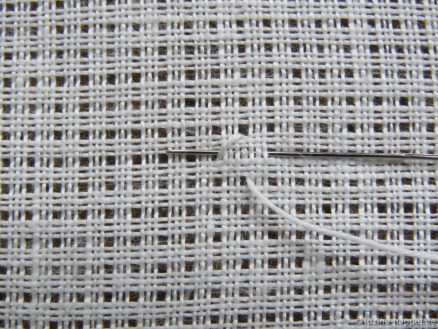


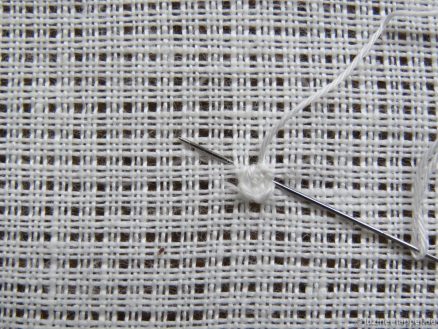


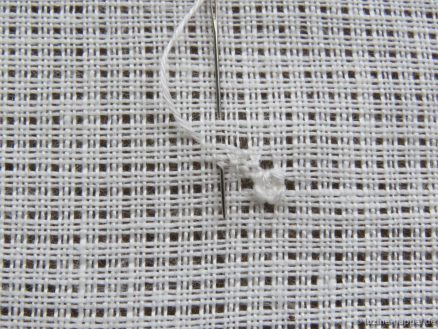
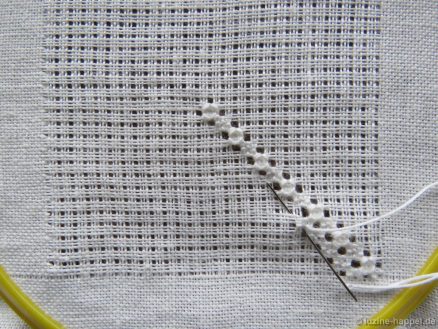
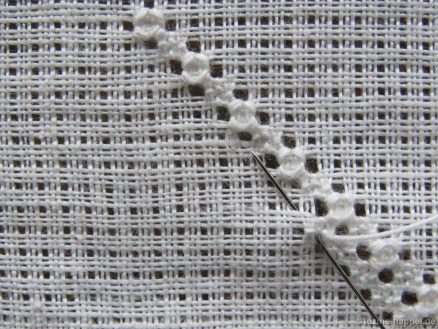
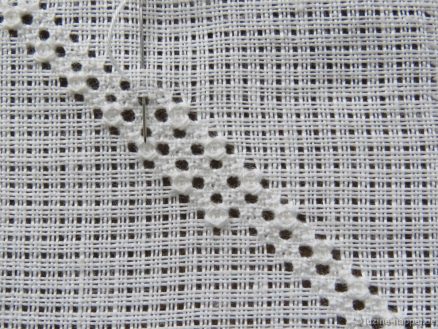

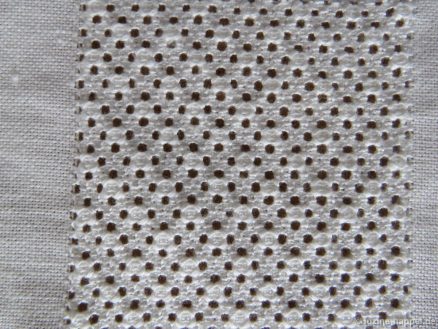


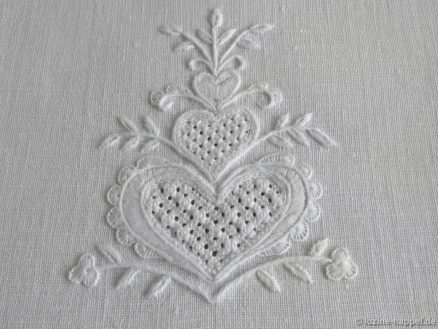


This is beautiful!
Thank you, Karen.
Yes, indeed it is beautiful. And if one has internalized the developement of the pattern, it is not so difficult to work.
Thank you, Karen.
There are so many beautiful patterns. Just I am working on a new to me pattern – cute and tiny. Good for small shapes. I will show it in any of my future articles.
Lovely!
Très beau….Merci à vous..
Beautiful and it looks easy to stitch. Thank you.
Sehr schöne Variante mit dem Rosenstich. Er ist einer meiner Lieblingsstiche und ich suche immer wieder andere Möglichkeiten ihn zu verwenden. Herzliche Grüße aus dem Gießener Raum. Ingrid
Danke!
Gerade habe ich wieder mal einen neuen Stich ausprobiert – sehr zart und fein, für kleine Flächen. Auch da spielt der Rosenstich eine Rolle. Diesen Stich werde ich in ein paar Wochen auf meinem Blog vorstellen.
Es muy bonito ese patrón y es una interesante variación para crear un especial trabajo en nuestros bordados Schwalm.
Muchas gracias por compartirlo con nosotros.
Dieses Muster ist sehr schön und es ist eine interessante Variation, um eine besondere Arbeit in unserer Schwälmer Stickerei zu kreieren.
Vielen Dank für das Teilen mit uns.
Hay tantos patrones hermosos, eso es lo que hace que el bordado Schwalm sea tan interesante.
Es gibt so viele schöne Muster – das macht die Schwalm stickerei so interessant.
There are so many beautiful patterns, that’s what makes Schwalm embroidery so interesting.
Hallo Frau Happel,ich sticke heute die Nr. 554 ich als Anfänger komme gut mit ihrer Erklärung klar,danke für die Erklärung
Eine schöne rest Woche noch
Lg
Dorothea Raum Dortmund
Es ist schön, dass auch Sie als Anfänger gut mit meinen Erklärungen zurecht kommen. So sollte es eigentlich immer sein, aber manchmal übersieht man als Fortgeschrittener eine Klippe, die sich Anfängern auftut.
Danke für Ihren Kommentar!